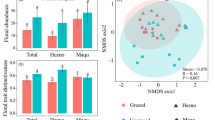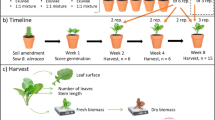Summary
Insect herbivory can have important effects on plant life histories and architecture. We quantified the impact that a cynipid gall wasp, Antistrophus silphii, had on growth, reproduction, and biomass allocation patterns of Silphium integrifolium growing in the tallgrass prairie of northeastern Kansas. Experimentally galled individual Silphium shoots (ramets) had reduced shoot growth, leaf and flower head production, and delayed flowering compared to gall-free control shoots. Gall formation completely halted normal apical growth in 65% of the shoots. Galling did not affect individual flower head weight, the numbers of achenes per flower head or achene weight. Silphium plants (genets) with a high proportion of galled shoots had lower total biomass, a lower proportion of total biomass allocated to flower heads, higher allocation to leaves, but no change in allocation to stems or rhizome. High gall densities reduced the number of flower heads per plant and shortened the time between flower head initiation and maturity. An adaptive interpretation of these results would be that the survivorship and future performance of galled Silphium may be promoted by maintaining allocation to rhizome. However, reduced shoot growth and delayed reproduction in galled Silphium may weaken its competitive ability and reduce pollination success, so that any adaptive advantage to Silphium's allocation responses to galls may be outweighed by disadvantages from its growth and flowering phenology responses. We conclude that a more parsimonious interpretation of these results is that gall-induced allocation changes are due to architectural constraints placed by galls on meristem activity, rather than to any adaptive response on the part of the plant.
Similar content being viewed by others
References
Antonovics J (1980) Concepts of resource allocation and partitioning in plants. In: Staddon JER (ed) Limits to action: the allocation of individual behavior. Academic Press, Orlando
Caldwell MM, Richards JH, Johnson DA, Nowak RS, Dzurec RS (1981) Coping with herbivory: Photosynthetic capacity and resource allocation in two semiarid Agropyron bunchgrasses. Oecologia 50:14–24
Craig TP, Price PW, Itami JK (1986) Resource regulation by a stem-galling sawfly on the arroyo willow. Ecology 67:419–425
Crawley MJ (1983) Herbivory: The dynamics of animal-plant interactions. University of California Press, Berkeley
Crawley MJ (1988) Herbivores and Plant Population Dynamics. In: Davy AJ, Hutchings MJ, Watkinson AR (eds) Plant population ecology, 28th Symposium of the British Ecological Society. Blackwell, Oxford
Dennill GB (1988) Why a gall former can be a good biocontrol agent: the gall wasp Trichilogaster acaciaelongifoliae and the weed Acacia longifolia. Ecol Entomol 13:1–9
Dirzo R (1984) Herbivory: a phytocentric overview. In: Dirzo R, Sarukhán J (eds) Perspectives on plant population ecology. Sinauer, Sunderland MA
Fedde GF (1973) Impact of the Balsam Woolly Aphid (Homoptera: Phylloxeridae) on cones and seed produced by infested Fraser fir. Can Entomol 105:673–680
Harper JL (1977) Population Biology of Plants. Academic Press, London
Hartnett DC (1990) Size-dependent allocation to sexual and vegetative reproduction in four clonal composites. Oecologia 84:254–259
Hartnett DC, Abrahamson WG (1979) The effects of stem gall insects on life history patterns in Solidago canadensis. Ecology 60:910–917
Jennersten O, Berg L, Lehman C (1988) Phenological differences in pollinator visitation, pollen deposition and seed set in the sticky catchfly, Viscaria vulgaris. J Ecol 76:1111–1132
Kinsman S, Platt WJ (1984) The impact of a herbivore upon Mirabilis hirsuta, a fugitive prairie plant. Oecologia 65:2–6
Lee TD, Bazzaz FA (1980) Effects of defoliation and competition on growth and reproduction in the annual plant Abutilon theophrasti. J Ecol 68:813–821
Marquis RJ (1984) Leaf herbivores decrease fitness of a tropical plant. Science 226:537–539
McCrea KD, Abrahamson WG, Weis AE (1985) Goldenrod ball gall effects on Solidago altissima 14C translocation and growth. Ecology 66:1902–1907
Milliken GA, Johnson DE (1984) Analysis of Messy Data. Lifetime Learning Publications, Belmont
Parker MA, Salzman AG (1985) Herbivore exclosure and competitor removal: Effects on juvenile survivorship and growth in the shrub Gutierrezia microcephala. J Ecol 73:903–913
Puritch GS, Talmon-De L'Armee M (1971) Effect of balsam woolly aphid, Adelges piceae, infestation on the food reserves of grand fir, Abies grandis. Can J Bot 49:1219–1223
Rausher MD, Feeny P (1980) Herbivory, plant density, and plant reproductive success: The effect of Battus philenor on Aristolochia reticulata. Ecology 61:905–917
Sacchi CF, Price PW, Craig TP, Itami JK (1988) Impact of shoot galler attack on sexual reproduction in the arroyo willow. Ecology 69:2021–2030
Samson DA, Werk KS (1986) Size-dependent effects in the analysis of reproductive effort in plants. Am Nat 127:667–680
Schowalter TD, Haverty MI (1989) Influence of host genotype on Douglas-fir seed losses to Contarinia oregonensis (Diptera:Cecidomyiidae) and Megastigmus spermotrophus (Hymenoptera:Torymidae) in western Oregon. Environ Entomol 18:94–97
Watson MA, Casper BB (1984) Morphogenetic constraints on patterns of carbon distribution in plants. Ann Rev Ecol Syst 15:233–258
Weis AE, Kapelinski A (1984) Manipulation of host plant development by the gallmidge Rhabdophaga strobiloides. Ecol Entomol 9:457–465
Whitham TG, Mopper S (1985) Chronic herbivory: impacts on architecture and sex experession of Pinyon Pine. Science 228:1089–1091
Author information
Authors and Affiliations
Rights and permissions
About this article
Cite this article
Fay, P.A., Hartnett, D.C. Constraints on growth and allocation patterns of Silphium integrifolium (Asteraceae) caused by a cynipid gall wasp. Oecologia 88, 243–250 (1991). https://doi.org/10.1007/BF00320818
Received:
Accepted:
Issue Date:
DOI: https://doi.org/10.1007/BF00320818




